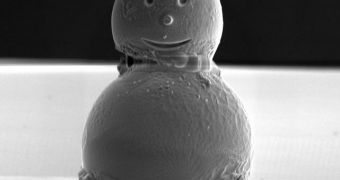Each year, as Christmas nears, members of the international scientific community start celebrating the season in their own way, by taking the high-tech approach. For instance, this year, experts at the UK National Physics Laboratory (NPL) have created a snowman, which would be nothing special in itself, if their creation wasn't just a few micrometers across. More clearly, the wonderful creation, which is composed entirely of two beads, is less than one fifth the width of a human hair in size, The Daily Mail reports. Though it may look cool, some pretty high-end technology was featured for it.
According to its creators, the new snowman is approximately 0.01 millimeters in size, which makes it far too small for the human eye to detect. This is a completely different approach from that children take when building the largest snowman, and endowing it with hands, a hat, nose, eyes and so on. The NPL research team managed to do all that as well, though not with carrots, coal and brooms, but with laser beams and advanced deposition processes. Their creation only makes sense when its image is amplified in blue light, they say.
The artifact is made up of two tin beads, of the kind that physicists usually use to calibrate their electron-microscope lenses. Just like in the case of telescopes, microscope lenses have to be fine-tuned as well before they can be used at their maximum capabilities, the NPL team says. They explain that, once the beads had been set atop each other, a focused ion beam was used to carve out the snowman's eyes and smile, with incredible accuracy. All of the small structures were handled with tools that experts regularly used to handle nanoparticles.
The components were welded to each other by using small platinum deposits, which allowed for the snowman to stand. Its nose was also made through platinum deposition, a process that required a lot of skill on the part of the scientists. Placing an incredibly small particle of platinum on an equally small bead is not an easy task, not even with the most advanced technological means at their disposal. In charge of the work has been Quantum Detection group member Dr. David Cox.

 14 DAY TRIAL //
14 DAY TRIAL //